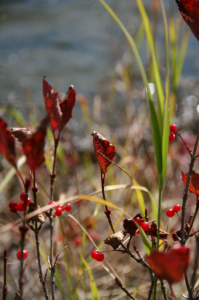
When bright green Alaska foliage starts to turn yellow, the pumpkins orange and the rolling tundra a deep rosy pink, we know that summer has come to an end. Fall has now passed us by as well, and judging by the snow-capped mountains in Anchorage and sub-zero temperatures, winter is swiftly on the horizon. Let us cozy up to the fire with friends and family, enjoy the glorious golden sunshine as it recedes into darkness and prepare our favorite autumn foods as we begin our yearly hibernation: Moose, caribou, lingering garden greens and herbs, salmon, pumpkins and wild berries.
Chutneys, sauces, jams and other acidic fruit preserves are a refreshingly tart way to brighten up a winter meal. I happened to find myself with 5 gallons of low-bush cranberries, handpicked and straight from the Interior. Check out one of my favorite ways to prepare the berries and then try your own experiments. Whether polka-dotted in a sourdough pancake mix or pressed into a potent juice of phytonutrients, fresh Alaskan wild harvested low-bush cranberries are a culinary delight.
Wild Alaskan Low-Bush Cranberry Sauce
What you need:
- For a nice sized bowl of sauce, 4 cups of cranberries
- A cup or so of water or juice so the berries don’t burn
- A pot, stove and mixing utensil
- Sweetener to taste and fun additional flavorings
- Hungry tummy
Mix the cranberries and the water/juice in the pot and set over a medium heat. Stir frequently and make sure that the berries are not burning on the bottom of the pot. The longer the berries cook the more jam-like they will become. I like a good thick sauce and therefore let the cranberries cook for about half an hour, or until all the extra water has evaporated out. The berries will start to pop and mush together, a lovely swirl of autumn fragrance in the kitchen air. When the berries reach your desired consistency, the cooking is complete. Cranberry sauce is very easy to make, full of antioxidants and amazingly strong in taste. The berries are also an easy ingredient to be creative with; try adding some of the following flavor mixes into your sauce-
- Honey and fresh rosemary (honey produces a runnier sauce because it is a dense sweetener and it does not gel the fruit as nicely as sugar does due of a difference in reaction with the natural pectin).
- Brown sugar, 3 cloves, a few chunks of fresh ginger and an apple or pear chopped into small pieces (sugar will make sauce more jam-like).
- Maple syrup and a whole orange, peel included, chopped into small pieces, a dash of cinnamon.
- A substantial amount of ground cardamom, nutmeg, cinnamon and clove (plus brown sugar as the sweetener) results in a subtle but distinct chai-flavor. If you enjoy looking for needles in haystacks, throw whole cardamom pods and cloves into the sauce and fish them out when the cooking is suffice. Using whole nutmegs and a small grater also provides for better aromatic and taste bud properties.
Voila! Enjoy the sauce with local cheese, spread over artisan bread or as a glaze on your favorite dinner meat. To preserve the cranberry concoctions for the long haul, check out the canning directions and safety tips from University of Alaska Fairbanks Cooperative Extensive Services. The recipe above will last for a little while in the refrigerator, about a week; to ‘put up’ the sauce, or preserve it like the jam and jelly found in grocery stores, food products must be processed in a hot water bath or a pressure cooker to kill potential harmful bacteria.
Jennifer Kehoe
The small organic farms of Massachusetts filled Jennifer Kehoe’s childhood with a bounty of apples, maple syrup and fresh dairy. She grew up on Hindu chanting, herbal tinctures, kale and kombucha, which fermented in the kitchen cabinets. Living in Alaska has introduced her to a whole new side of simple, natural and local living and she is dedicated to learning and teaching about the art, history and science of self-sufficiency. Jennifer believes food should be pleasurable and fun, but that it is also a vital path to social, economic and environmental sustainability.
The Anchorage Food Mosaic’s mission is to build and celebrate community through our cultural foods.
In our current conventional agricultural system, a monoculture replaces lots of genetically diverse plants with one uniform crop, which is highly susceptible to disease and failure. In the same way that monocropping is dangerous to the future of a crop; we must encourage diversity within our community to prevent disease.
In order for our community to thrive we need to embrace and nurture the “mosaic” of people in this city.
The Anchorage Food Mosaic features different community members through photos and traditional recipes. Let us cook each others cultural foods and share our stories with one another.





